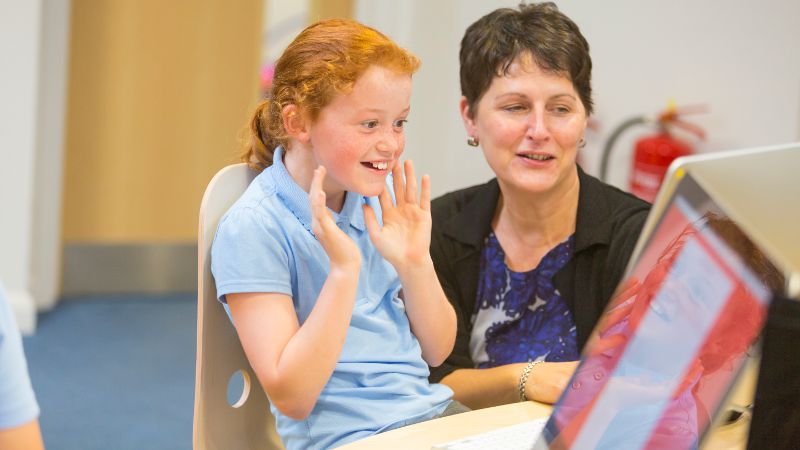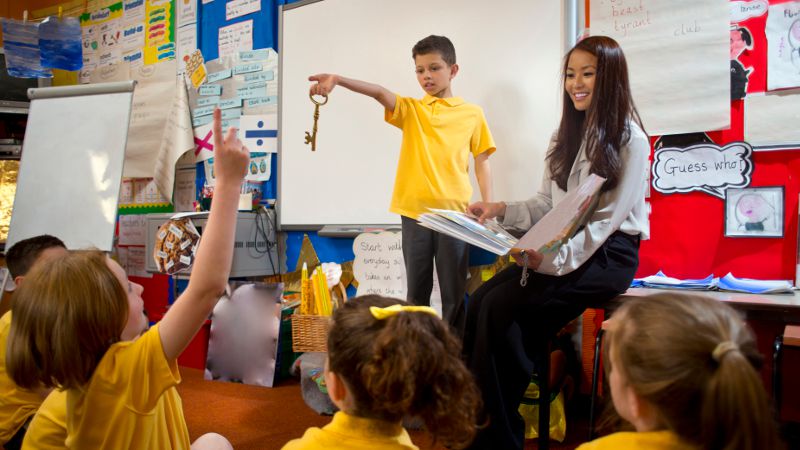
10 Behaviour Management Techniques Every Education Professional Needs to Know
A Guide for Classroom Teachers and Teacher Aides

The following 10 techniques is certainly not the important behaviour management techniques, nor the most common, yet they are an important and valuable addition to your teaching repertoire.
1. Redirect
The student is redirected from an off-task activity to an on-task activity.
Redirection is simply moving a student’s attention from one thing to another. For example, Emily is talking with Zane. You redirect them back to the task at hand by saying ‘Emily and Zane, I’ll be over in 3 minutes to look at your answer to Question 12’. Similarly, if a student is off-task and distracting others, you may call the student over and have him or her explain how to do Question 12. The student is redirected from an off-task activity to an on-task activity.
Hint: One of the easiest ways to direct a student’s attention back to the task at hand is to simply say, 'where are you up to?'
‘Defusing’ is a type of redirection that can be done to reduce or extinguish conflict or tension. For example, Petra and Shari begin arguing over something insignificant. To defuse the situation, you ask them to each do a simple job for you (such as to sort the books into alphabetical order or hand out resources). This defuses the situation because their attention is redirected elsewhere. The critical component of this technique is to make sure that neither student feels like they were punished in some way.
2. Let Them Decide
If a student misbehaves, teachers might ask him or her what a reasonable response or consequence should be. Assume a student has been talking to their neighbour incessantly and warned several times. The teacher says, ‘Zane, what do you think I should do given that you have had several warnings but decided to continue talking?’.
This also works with students who believe that they have been wronged in some way by another student. Ask them what they would like to see happen or what consequence they think is fair and reasonable. This goes a long way to resolving the situation as the aggrieved party gets to suggest a consequence. Teachers do not have to abide by their student’s recommendations and can suggest acceptable alternatives. Strangely enough, even in the heat of battle children are very forgiving of their peers and often suggest very light sentences for their temporary opponents.
Teachers do not have to abide by their student’s recommendations and can suggest acceptable alternatives.
3. No Negotiation

While negotiation may be useful in some instances, it is a time-consuming tactic that teachers use sparingly.
Sometimes the teacher will be happy to negotiate with a student. This might happen when having a quiet word outside the room or as a precorrection as you have read so far. In most cases however, the teacher has no interest, inclination or time to negotiate. To engage in a negotiation only bolsters the student’s position and helps them to achieve their off-task or attention-seeking goals. While negotiation may be useful in some instances, it is a time-consuming tactic that teachers use sparingly.
More often than not, a teacher will provide an instruction and then expect compliance – there is no negotiating or back and forth on the issue. If a student argues, the teacher may say, ‘no arguments, I’m busy’ or ‘we can talk about this during your lunch break if you prefer, but right now is learning time’. Few students feel strongly enough to give up their lunch break to argue with their teacher. The point is that teachers should avoid the temptation to play the ‘back and forth’ game unless there is a very good reason to do so. If a student argues, simply repeat your instructions or consider a firm statement such as, ‘no negotiations, no arguments’ and turn away expecting compliance.
4. Ignore Secondary Behaviour
Secondary behaviour is the classic ‘kick the chair on the way out’, face-saving reaction to being removed from class or relocated. These behaviours can be ignored for the most part as they are not squarely aimed at the teacher (the root cause is saving face). There are many different ways that this behaviour can manifest in the classroom environment. Some students will swear, throw another piece of paper when told not to, delay their response in some way, stamp their feet, scream or even say something offensive to the teacher.
Remember that students use secondary behaviours for one purpose and one purpose only – to save face (Rogers, 1998). Do not ‘bite’ when you see them happen – they are not a challenge to your authority – students who use them are complying with your instructions so thank them politely and continue teaching. If one of your students kicks a chair on the way out, simply pick it up and continue with the lesson like nothing happened. Whatever you do, don’t act like the secondary behaviour offended you in some way – act like nothing happened instead. You have achieved your original goal as the student has complied with your instructions.
Students use secondary behaviours for one purpose and one purpose only – to save face (Rogers, 1998).
References:
Rogers, W. (1998). You know the fair rule. ACER.
5. Make a Deal

Sometimes students need cajoling and here is one little way to make that happen – make a deal. There are many different ways that teachers can go about making a deal. On an individual basis, the teacher may make a deal with a student in terms of seating arrangements. It could go down like this, ‘I will make you a deal – if you sit at your seat quietly and work on your project, I will go and see if I can find some special paint for next lesson – deal?’. Sometimes students need to be reminded of their special deals but nonetheless they can be an effective motivational tool.
On a whole-of-class basis, the teacher may have planned a game or quiz for the last 15 minutes of the lesson. A deal can be struck here. The teacher asks the class if they would be interested in playing a game (obviously the answer is ‘yes’). The teacher then says, ‘okay once we get these 8 maths problems done, check them, and make sure everyone knows how to do them, then we’ll play a game – do we have a deal?’
6. Work It Off
One of the oldest tricks in the book goes like this: the teacher puts a student’s name on the board (usually in the top right-hand corner) and tells the student he or she can ‘work it off’. Students are very familiar with this game and further explanation is often not required. They know how to play and will eagerly participate in most instances – no one wants their name on the board after all. If the student is well-behaved for the rest of the lesson or the teacher ‘catches them out doing good’, their name comes off the board and there are no consequences.
However, if the student is not working quietly (or on whatever it is they are supposed to be doing), the teacher leaves their name on the board until the end of class. When the class ends, the student stays back for a quiet chat or some other consequence (such as to pick up 10 pieces of rubbish which usually takes 30 seconds or so). As this is a game of sorts, keep it light and ensure you are not publicly embarrassing the more introverted members of your class. The middle-grounders usually don’t belong in this game and will not appreciate their inclusion – students have long memories if you embarrass them in front of their peers.
Hint: Teachers love to say, ‘6 minutes to go, if your name is on the board you can work it off and leave with everyone else but only if you have perfect behaviour for the next 6 minutes’. This gives students an opportunity to redeem themselves and helps the teacher to manage the final stages of the lesson. Also, no teacher wants to stay back with students unless they really have to – coffee awaits!
7. Give Them an Outlet for Their Energy

Sitting down for extended periods is tedious and challenging. Why then do we ask children to sit down for hours on end? In some senior schools, students attend 2-hour lessons or they are in class for 2 x 1-hour lessons back-to-back (e.g. 8:30 – 10:30). Even for most adults, 2 hours is a long time to concentrate without stretching your legs. Try reading a book or writing an essay for 2 hours straight – it’s not easy. Consider allowing students to stand up and stretch now and then – the teacher can even lead a quick 3-minute stretching session while explaining the names of muscles and bones.
Another option is a quick game to give students a short rest. This is particularly useful for hard-working classes who are not likely to get overly excited or unsettled. For fidgety teenage boys who love sport, learning by doing, learning by moving and learning by walking strategies prevent many behavioural issues. Giving students an outlet for their energy can be as simple as having them move around the room from time to time.
Hint: The fancy term for this strategy is ‘movement integration’(or MI) and it can also be used to boost students’ daily physical activity (Webster et al., 2017).
References:
Webster, C. A., Zarrett, N., Cook, B. S., Egan, C., Nesbitt, D., & Weaver, R. G. (2017). Movement integration in elementary classrooms: Teacher perceptions and implications for program planning. Evaluation and Program Planning, 61, 134.
8. Refer to a Higher Authority
While devastatingly effective, this technique is sadly underused. Referring to a higher authority helps the teacher with the dreaded ‘why…but why…’ line of questioning. The teacher can easily refer the student to the class rules, the school policy, and even the law. Students find it very difficult to argue against your classroom behaviour management plan when it is applied systematically and in a fair and reasonable manner. Phrases such as ‘sorry John, that’s just the rules so I have no choice buddy’ are accepted by most students as legitimate explanations.
Another effective manoeuvre is to say, ‘every other class in the school has the same rule’. Adding some humour may also reduce tension while still getting the message across, such as ‘you’ll need to send a letter to the government to ask them to change the rules okay – once you get a reply, we can chat about it then – until then…’. Similarly, an old chestnut is ‘if I don’t follow the rules, I will probably get fired so sorry Johnny, but you will need to…’ Don’t overuse this technique but certainly keep it in your toolbox for the right moment – it may just get you out of a pinch.
Referring to a higher authority helps the teacher with the dreaded ‘why…but why…’ line of questioning.
9. Delay
This technique is used in conjunction with many others found in this book. While we have mentioned it elsewhere, it’s important enough to devote a specific section to it. Once you start using the delay technique, you will wonder how you survived without it. A natural instinct of new and inexperienced teachers is to feel that they must deal with behavioural issues when and where they happen. In fact, most behaviour management books and courses state that behaviour should be dealt with straight away. While behaviour in some instances must immediately be addressed due to its seriousness or repetitiveness, it can often be completely ignored, or the response delayed until a later time.
Provided the misbehaviour has ceased, ‘dealing with it’ can be a future task. The trick is to teach students that you will not forget and that you will always follow up. This approach emphasises the importance of on-task behaviour while disempowering attention-seekers and off-taskers. Simply have a quiet word with the student when and where it suits you – not when or where it suits them. This may mean a chat next time you pass by his or her desk; it may mean at the next break or transition period. No matter when the teacher chooses to deal with an issue, remember the whole reason for behaviour management techniques in the first place: to stop undesirable behaviours in their tracks, to stop them from repeating and to maximise time spent on learning tasks. You can achieve all 3 of these even with a long delay or half response (half now, half later).
The trick is to teach students that you will not forget and that you will always follow up.
10. No-Cost Rewards

Similar (and related to) the token economy, no-cost rewards are motivational tools used in addition to techniques such as ‘catch them doing good’. They are rewards that teachers give to students which have no monetary value – they don’t cost the teacher or any other person a cent. There is no bag of confectionery or other trinkets to worry about.
Here is a list of 10 no-cost rewards that your students will appreciate:
- Taking off their shoes in class
- Extra computer time
- Choosing where to sit (including at the teacher’s desk)
- Sitting in the reading corner for maths
- Choosing the book for class reading time
- Writing the date on the board each morning
- Being a teacher helper
- Marking the attendance sheet
- Being a line leader for a day
- Choosing a class game.
The teacher might spot a student doing what he or she is supposed to be doing – nothing out of the ordinary. To encourage this type of behaviour, the student is awarded a no-cost reward. He or she gets to wear a hat inside for a lesson or perhaps to be the first person to leave the room for lunch or even be allowed to sit at the teacher’s desk for a period of time.
Hint: No-cost rewards also serve as public acknowledgements of a student’s positive performance or work. They are applied randomly and sparingly (such as once per lesson). There is no formal system as there is for traditional token economies.























